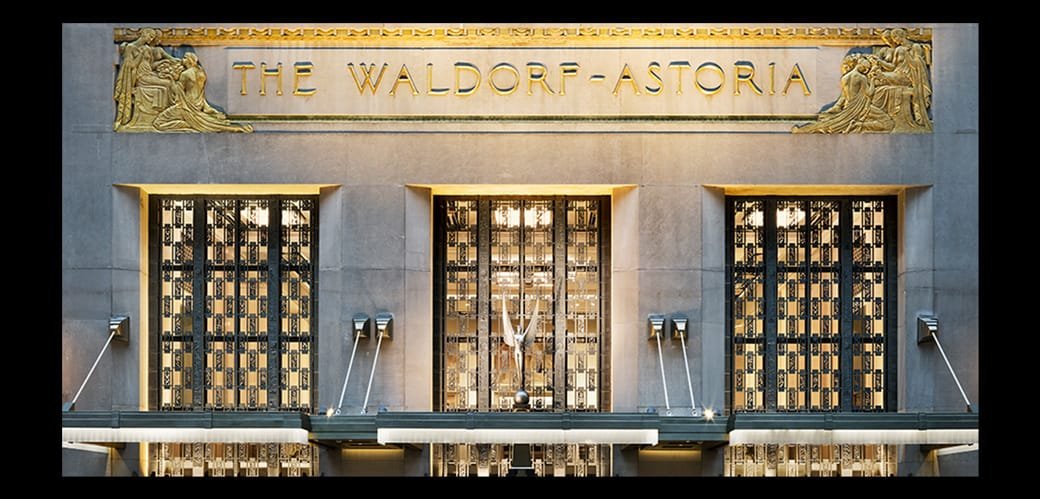The Waldorf Astoria New York is a luxury hotel in Manhattan, New York City. The hotel has been housed in two historic landmark buildings in New York. The first, bearing the same name, was built in two stages, as the Waldorf Hotel and the Astor Hotel, which accounts for its dual name. That original site was situated on Astor family properties along Fifth Avenue, opened in 1893, and designed by Henry J. Hardenbergh. It was demolished in 1929 to make way for the construction of the Empire State Building. The present building, at 301 Park Avenue between 49th and 50th Streets in Midtown Manhattan, is a 47-story 190.5 m (625 ft.) Art Deco landmark designed by architects Schultze and Weaver, which was completed in 1931. The current hotel was the world’s tallest hotel from 1931 until 1963, when it was surpassed by Moscow’s Hotel Ukraina by 7 metres (23 ft.). An icon of glamour and luxury, the current Waldorf Astoria is one of the world’s most prestigious and best-known hotels. Waldorf Astoria Hotels and Resorts is a division of Hilton Hotels, and a portfolio of high-end properties around the world, now operate under the name, including New York.
From its inception, the Waldorf Astoria gained international renown for its lavish dinner parties and galas, often at the center of political and business conferences and fundraising schemes involving the rich and famous. Particularly after World War II it played a significant role in world politics and the Cold War, culminating in the controversial World Peace Conference of March 1949 at the hotel, in which Stalinism was widely denounced. Conrad Hilton acquired management rights to the hotel on October 12, 1949, and the Hilton Hotels Corporation finally bought the hotel outright in 1972. It underwent a $150 million renovation by Lee Jablin in the 1980s and early 1990s, and in October 2014 it was announced that the Anbang Insurance Group of China had purchased the Waldorf Astoria New York for US$1.95 billion, making it the most expensive hotel ever sold. On July 1, 2016, Anbang announced that it would convert some of the Waldorf’s hotel rooms into condominiums, closing the hotel for a three-year renovation on March 1, 2017.
Following are the various stories that give us insights on the conservation efforts, people and organisations that strived hard to preserve the luxury hotel which is a historic landmark building.
WALDORF ASTORIA NEW YORK EMBARKS ON MAJOR RESTORATION AND RENOVATION
Published: Press Center of the Waldorf Astoria Website on March 01, 2017
http://news.waldorfastoria.com/index.cfm/news/waldorf-astoria-new-york-embarks-on-major-restoration-and-renovation
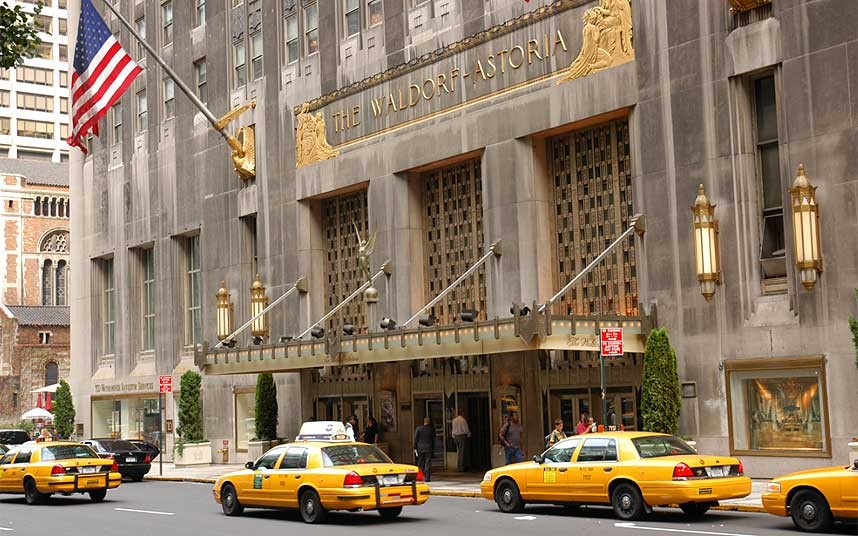
Background Statement
The Waldorf Astoria New York will undergo a complete renovation and restoration and is planned to reopen in two to three years. It will continue to be operated by Hilton as part of a 100-year management agreement. Waldorf Astoria New York will feature restored historic public and event spaces along with luxury condominiums and guest rooms and suites that will set a new standard for luxury and service in New York. The hotel will begin its temporary closure on March 1. Initial construction will be limited to areas of the hotel that are not landmarked or designated for potential landmark status while a public review process for those spaces is ongoing. More detailed design plans and renderings will be shared as part of the public review process. Originally opened in 1893 on the present site of the Empire State Building, the Waldorf Astoria New York opened at its current Park Avenue location in 1931 and was designated an official New York City landmark in 1993.
“The Waldorf Astoria New York is where our brand’s story began. Restoring this hotel to its place as the most luxurious hotel in New York is a key priority for the Waldorf Astoria brand. Through this restoration, Waldorf Astoria will ensure that all global luxury travellers receive an unforgettable experience.”
– John T.A. Vanderslice, global head, Waldorf Astoria Hotels & Resorts.
“The Waldorf Astoria New York is part of the fabric of New York City. As stewards of this iconic landmark and its historic legacy, we are committed to restoring its public spaces to their original beauty, ensuring that the hotel retains its rightful place as a premier focal point for the city and a premier destination for the world.”
– Anbang Insurance Group
DECO IN DANGER- WE NEED YOUR HELP TO SAVE THE WALDORF ASTORIA HOTEL
CITATION: http://artdeco.org/preservation
We are distressed to learn that the world’s preeminent Art Deco hotel will be gutted and turned into condos and fear that the lobby, entrances, Louis Rigal murals, and other great public spaces, such as the Grand Ballroom, will be destroyed.
We need your help immediately to convince the Landmarks Preservation Commission to act quickly to calendar and designate the public interior spaces of the iconic Art Deco masterpiece, the Waldorf Astoria Hotel.
This week The Wall Street Journal article, “Classic Waldorf Hotel to Be Gutted, up to 1,100 Rooms Turned into Condos,” reported that the Waldorf-Astoria interiors are in jeopardy.
THE WALL STREET JOURNAL ARTICLE:
Classic Waldorf Hotel to Be Gutted, up to 1,100 Rooms Turned into Condos:
By CRAIG KARMIN
PUBLISHED: JUNE 27, 2016
China’s Anbang, acquirer of the New York landmark, is finalizing plans to shut the hotel for up to three years and convert as many as three-quarters of its rooms into private apartments.
The Chinese acquirer of the Waldorf Astoria is finalizing plans for an extensive overhaul that would shut the landmark New York hotel for up to three years and convert as many as three-quarters of its rooms into private apartments, people familiar with the matter said.
Anbang Insurance Group Co.’s restoration plan calls for closing down the 1,413-room property in the spring, removing as many as 1,100 hotel rooms and eliminating hundreds of hotel jobs, the people said.
When the Waldorf reopens, the hotel will feature between 300 and 500 guest rooms upgraded to luxury standards, the people said. The remaining units will be sold as condominiums.
The vast reduction in Waldorf hotel rooms will lead to the elimination of many room-service, housekeeping and other hospitality jobs. The Waldorf has about 1,500 hotel employees. The new owners and Hilton Worldwide Holdings Inc., which will continue to manage the property when it reopens, have reached severance agreements with hundreds of these workers at a cost of $100 million or more, some of the people familiar with the matter said.
The insurer plans to meet with Waldorf representatives during the next couple of weeks to finalize its proposal for the property, some of the people said. “We continue to explore all options,” an Anbang spokesman said. “We have no definitive plans at this time.”
The redevelopment costs are expected to run to more than $1 billion, said people familiar with the plan. Anbang already spent $1.95 billion to acquire the property last year, the steepest price tag ever for a U.S. hotel.
The changes will radically transform an 85-year-old institution that has played a storied role in American political and cultural life. Occupying a full city block on Park Avenue, the Waldorf gained world-wide attention for its luxury suites, lavish parties and famous guests. Every president since Herbert Hoover has stayed there, and it has been a New York home to celebrities such as Gen. Douglas MacArthur, Frank Sinatra, and the Duke of Windsor after he abdicated his throne to marry American socialite Wallis Simpson.
Hotelier Conrad Hilton, who acquired control of the property in 1949, once scribbled on a photo of the hotel that it was “The Greatest of Them All.”
More recently, the hotel has struggled to live up to its history, and some guests and hoteliers say an upgrade is long overdue. The suites in the Waldorf’s tower building have their fans, but complaints about the hotel’s standard rooms are common.
President Barack Obama, who has previously stayed at the Waldorf, bypassed it for another hotel during a visit last year to Manhattan for the United Nations General Assembly. While the White House didn’t offer a specific reason for the change, people familiar with the matter pointed to possible security concerns under Anbang’s ownership.
Anbang has shared little publicly about its plans for the Waldorf and has mostly avoided press attention since its failed takeover effort for Starwood Hotels & Resorts Worldwide Inc. Marriott International Inc. acquired the rival lodging company after Anbang walked away from its $14 billion offer for Starwood citing “various market considerations.”
Anbang Chairman Xiaohui Wu previously hinted at his company’s vision for the Waldorf Astoria early last year when speaking before an audience at Harvard University. He said he planned to convert hotel rooms to condos and suggested that there would be an element of exclusivity.
“A potential buyer needs more than money to qualify for our apartments,” he boasted to the Ivy League crowd.
Condo conversions of historic New York hotels have become increasingly common over the years, with developers finding that high-end residential sales often pay better than being a hotelier.
Morgan Stanley hotel analyst Thomas Allen wrote in 2014, when Hilton still owned the Waldorf, that based on sales at other luxury Manhattan condo buildings, a conversion of the historic hotel could help raise $4 billion in condo sales under a best-case scenario.
But Manhattan’s high-end condo market has been under pressure over the past year, with prices falling and days on the market rising. The number of contracts signed for units at $4 million or more during the first 25 weeks of this year fell 22% compared with the period last year, according to luxury broker Olshan Realty Inc.
“There’s just too much inventory that’s overpriced,” said Donna Olshan, the firm’s president. “We’re past the peak.”
A previous owner of New York’s Plaza Hotel battled the hotel union and preservationists when he converted hundreds of rooms to condos about a decade ago. After a sales slump following the financial crisis eased, some Plaza condos have sold for tens of millions of dollars.
When speaking at Harvard last year, Mr. Wu floated a Waldorf perk for those who wanted to join his company. “If you become an employee of Anbang, you will be entitled to a free dinner and a free room night when you get married,” he said.
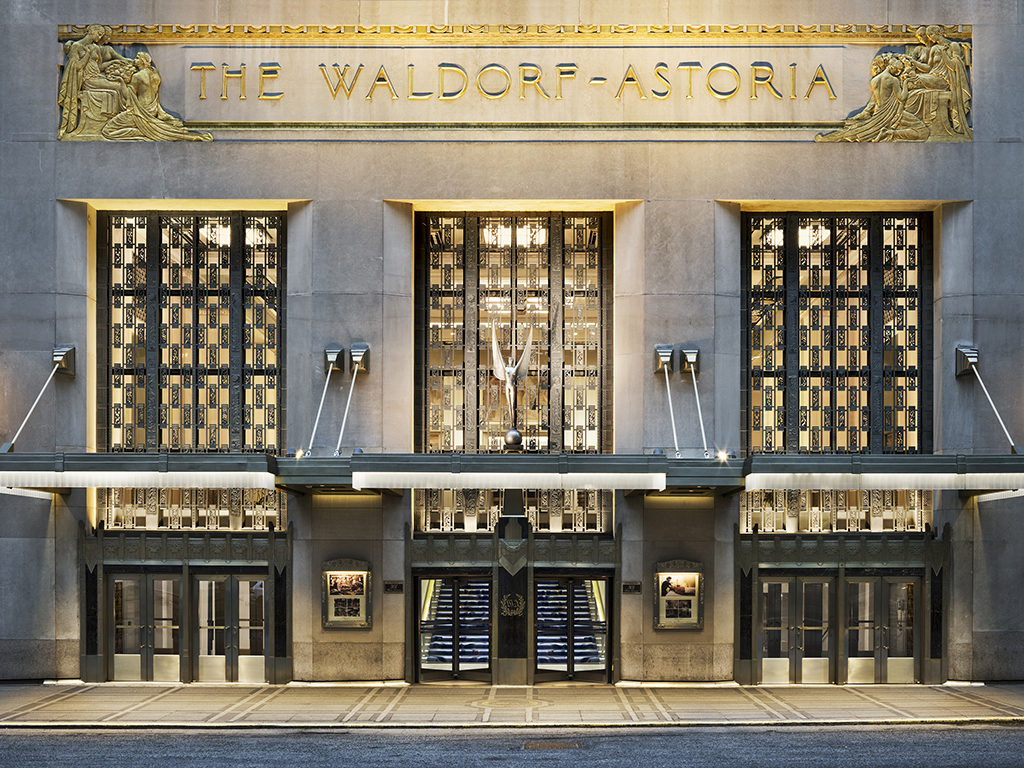
LANDMARKS COMMISSION PROTECTS ICONIC INTERIOR SPACES OF THE WALDORF-ASTORIA HOTEL
LPC Designates Hotel’s Most Celebrated Spaces, Including the Park Avenue Lobby, Grand Ballroom and Silver Gallery
Published on: NYC Landmarks Preservation Commission on the Tuesday, March 7, 2017
http://www1.nyc.gov/site/lpc/about/pr2017/030717.page
The New York City Landmarks Preservation Commission today unanimously voted to landmark several interior spaces of the Waldorf-Astoria Hotel in Manhattan. Considered one of New York City’s most prominent and culturally significant hotels, the Waldorf-Astoria was designed by Schultze and Weaver and opened in September 1931. The hotel’s exterior became a New York City landmark in 1993. Today’s vote will protect the building’s most lavish public spaces, including interconnected rooms and corridors on the ground, first, second and third floors. The designation brings the number of New York City Interior Landmarks to 119.
“The Waldorf Astoria Hotel has some of the most internationally renowned rooms in all of New York City,” said Commission Chair Meenakshi Srinivasan. “These designated spaces connect seamlessly from the foyers and lobbies on the ground and first floor to the Grand Ballroom and other public rooms on the third floor. Today’s action not only protects the rich and beautifully detailed art-deco features of the hotel’s interior public spaces, it also preserves the unique experience of moving through the hotel’s varied interiors, which countless New Yorkers and visitors have enjoyed for more than eight decades.”
Designated spaces on the first floor include the lofty Park Avenue Lobby (at left), an entry hall with 13 murals and an immense floor mosaic by the French artist Louis Rigal, and the elegant wood-panelled Main Lobby, featuring black marble pillars and ceiling reliefs. On the east end of the first floor, near Lexington Avenue, are elevators with distinctive metal doors and double staircases with “frozen fountain” balustrades leading through the first, second and third floors.
On the third floor, designated spaces include the glittering Silver Gallery, a long-mirrored hallway with a black-and-white mosaic floor that links four ballrooms. The Silver Gallery has a coved ceiling that incorporates 12 murals by the American artist Edward Emerson Simmons. The murals, which depict the months of the year, are among the only features salvaged from the hotel’s original Fifth Avenue building. The Grand Ballroom, one of the largest event spaces in the New York City, can accommodate as many as 1,550 guests. Arranged on three levels, the space has projecting balconies and an elaborate ceiling relief. This fabled room has hosted countless dinners, banquets, galas and balls, including the annual Alfred E. Smith Dinner, a fundraiser for Catholic charities that attracts major presidential candidates.
Also on the third floor is the Basildon Room, which has colourful wall and ceiling panels acquired from an 18th century British mansion, as well as the more restrained Jade Room and Astor Gallery. While these memorable interiors have had alterations and sometimes exhibit new finishes, most retain their original dimensions and share such unifying elements as gilded plaster reliefs, nickel-bronze metalwork, glazed doors, mirrored walls and various types of exotic wood panelling.
Over the years, the hotel’s Art Deco and Modern Classical style motifs create strikingly elegant spaces that have played host to an impressive roster of guests, including numerous political leaders and popular entertainers. The Waldorf-Astoria Hotel is one of two major early 20th-century hotels in New York City that have preserved many of their original public spaces. While the Plaza Hotel, which had its interiors designated in 2005, features Renaissance Revival style decoration, the Waldorf is notable and unique for containing some of the finest and most culturally significant Art Deco interiors in New York City.
The Landmarks Preservation Commission is the mayoral agency responsible for protecting and preserving New York City’s architecturally, historically and culturally significant buildings and sites. Since its creation in 1965, LPC has granted landmark status to more than 36,000 buildings and sites, including 1398 individual landmarks, 119 interior landmarks, 10 scenic landmarks, and 141 historic districts and extensions in all five boroughs. Under the City’s landmarks law, considered among the most powerful in the nation, the Commission must be comprised of at least three architects, a historian, a realtor, a planner or landscape architect, as well as a representative of each borough.
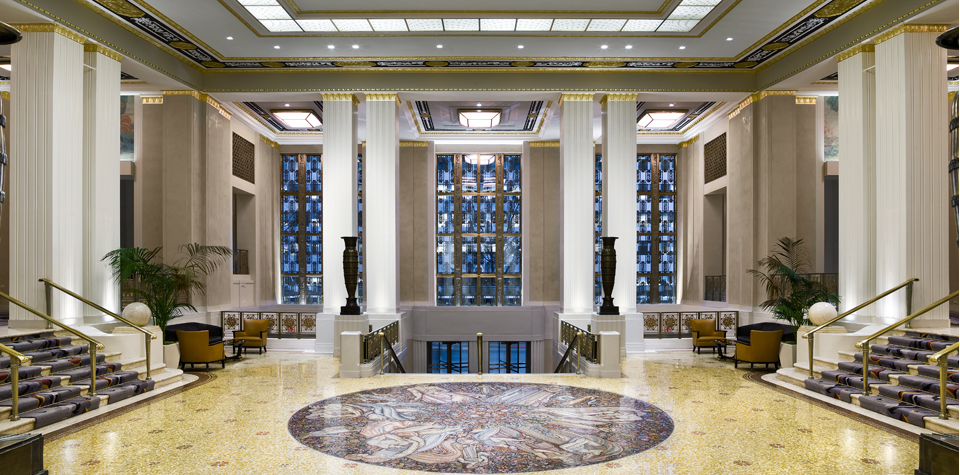
WALDORF ASTORIA NEW YORK RELEASES PROPOSED PLANS FOR EXTENSIVE RESTORATION OF LAND MARKED EXTERIOR AND INTERIOR SPACES
Design vision from Skidmore, Owings & Merrill and Pierre-Yves Rochon will protect beloved spaces and restore original features of the Waldorf not seen for decades
Published: Press Center of the Waldorf Astoria Website on March 29, 2017
http://news.waldorfastoria.com/index.cfm/news/waldorf-astoria-new-york-releases-proposed-plans-for-extensive-restoration-of-landmarked-exterior-and-interior-spaces
Waldorf Astoria New York today released proposed plans for the meticulous restoration and revitalization of the historic property’s landmarked exterior and interior spaces. The plans, which were prepared by a world-class design team including leading architectural firm Skidmore, Owings & Merrill (SOM) and renowned interior designer Pierre-Yves Rochon (PYR), were submitted today for public review by the New York City Landmarks Preservation Commission. The plans restore all landmarked spaces, ensuring the historic public and event spaces will be accessible for generations of New Yorkers and visitors alike.
This restoration is among the most complex and intensive landmark preservation efforts in New York City history. If approved, it will revive key elements of the Art Deco masterpiece that have been altered over time, providing an experience that reflects the hotel’s original intent while delivering an enhanced visitor experience by modernizing the building’s functional capability to a 21st Century standard of luxury.
The proposed restoration plan is part of a major renovation that will set a new standard for service in New York when The Waldorf re-opens in two to three years. The hotel will continue to be operated by Hilton as part of a 100-year management agreement.
“We are at an exciting and transformative point in Waldorf Astoria’s renowned history, during which time Waldorf Astoria New York will be restored to its original grandeur while maintaining a modern and inspirational look and feel,” says John T. A. Vanderslice, global head, Waldorf Astoria Hotels & Resorts. “It is an honor to be working with such a talented architectural and design team to breathe new life into this iconic hotel and provide unparalleled True Waldorf Service to its future guests.”
“We have assembled a world-class design team with unparalleled experience restoring and revitalizing historic properties to create a proposed plan that treats the Waldorf Astoria New York’s history with respect and dedication to detail,” said Brandon Dong, Anbang, which owns the Waldorf Astoria New York. “The restoration of the beautiful landmarked spaces is central to the Waldorf Astoria New York’s future as a New York City icon and global destination.”
SOM will lead the architectural design team for the project. The New York-based architecture firm has overseen restoration and adaptive reuse projects for several New York City landmarks, including Moynihan Train Hall, the General Electric Building headquarters and Lever House.
PYR will lead the interior design of the hotel, including its public and guest room areas. Since its founding in 1979, the firm has focused exclusively on five-star luxury hotels – including the forthcoming Waldorf Astoria Beverly Hills scheduled to open June 2017 – fine dining restaurants and private residences. PYR’s interior design has helped preserve the spirit and design heritage of some of the world’s most iconic hotels.
“Our design for the Waldorf Astoria New York reclaims the full potential of one of New York City’s most legendary buildings and opens a new chapter in the hotel’s celebrated history. The Waldorf Astoria has been an audacious civic icon since it first opened in 1931, and we are honoured to be leading the effort to restore this Art Deco masterpiece, while turning it into a world-class destination for the 21st century,” said Roger Duffy, Design Partner, SOM.
“Protecting the spirit of this iconic property and reflecting its history through a modern, more forward-thinking lens will be at the heart of the hotel’s interior design. From the overall atmosphere, down to the finest Art Deco details, American grandeur and international glamour will meet in the Waldorf Astoria New York – no other hotel in New York will compare,” said Pierre-Yves Rochon, Principal and Global Design Director, PYR.
In addition to historic public and event spaces restored to their original intent, the Waldorf will feature new guest rooms, suites and condominiums when it reopens.
Originally opened in 1893 on the present site of the Empire State Building, the Waldorf Astoria New York opened at its current Park Avenue location in 1931, was designated an official New York City landmark in 1993 and had its most important interior spaces land-marked in 2017.
WALDORF ASTORIA RESTORATION PLANS UNVEILED FOR LAND- MARKED INTERIOR, EXTERIOR
Published: By Ivan Pereira ivan.pereira@amny.com March 29, 2017
http://www.amny.com/real-estate/waldorf-astoria-restoration-plans-unveiled-for-landmarked-interior-exterior-1.13333879
Waldorf Astoria owners revealed renderings of their renovation plans for the landmark hotel on Wednesday, a beautification process that they said would preserve its historic past while instilling a modern spirit.
Owners submitted their proposals to the city’s Landmark Preservation Commission for the makeover, which would cover the lobby and ballrooms and other ground floor space. Those sections of the hotel were landmarked earlier this month.
The midtown institution is closed for two to three years as it goes through a massive conversion of most of the rooms into condos. The owners, China’s Anbang Insurance Group, expressed commitment to preserving and enhancing the public areas.
“The restoration of the beautiful landmarked spaces is central to the Waldorf Astoria New York’s future as a New York City icon and global destination,” Anbang managing director Brandon Dong said in a statement.
The LPC, which has to approve the renovations to the landmarked spaces, declined to comment about the proposal. The 86-year-old hotel’s exteriors were landmarked in 1993.
Architecture firm Skidmore, Owings & Merrill and interior designer Pierre-Yves Rochon will spearhead the work across the hotel.
They will revive the art deco style, repaint the walls, repair the floor mosaic and polish the gold and stone statues in the foyer.
“Protecting the spirit of this iconic property and reflecting its history through a modern, more forward-thinking lens will be at the heart of the hotel’s interior design,” Rocohon said in a statement.
The ground floor rooms have hosted thousands of events for presidents, foreign leaders and other dignitaries such as the Alfred E. Smith Foundation Dinner, which has taken place annually since 1945. This year’s dinner will take place at the Midtown Hilton.
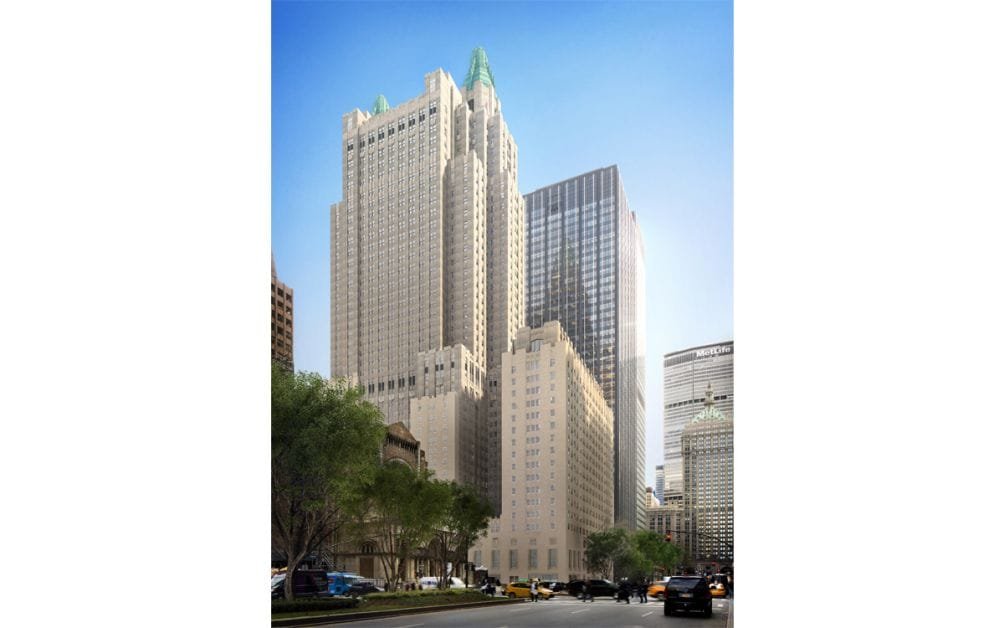
Waldorf exterior updates
The planned exterior of the Waldorf Astoria, located at 301 Park Ave. in Manhattan, is shown in this rendering. The building was designated an official New York City landmark in 1993.(Credit: Skidmore, Owings & Merrill LLP / Rendering by Methanoia Inc.)
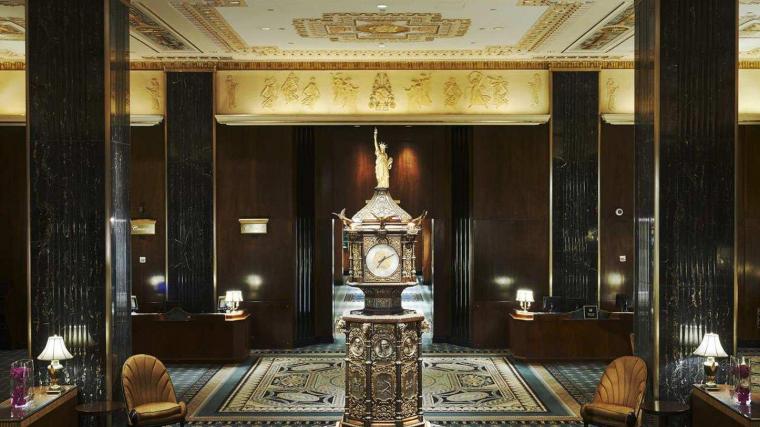
Waldorf Astoria lobby
A rendering of what the Waldorf Astoria lobby would look like if the developers’ plans are approved by the Landmarks Preservation Commission.(Credit: Skidmore, Owings & Merrill LLP / Rendering by Methanoia Inc.)
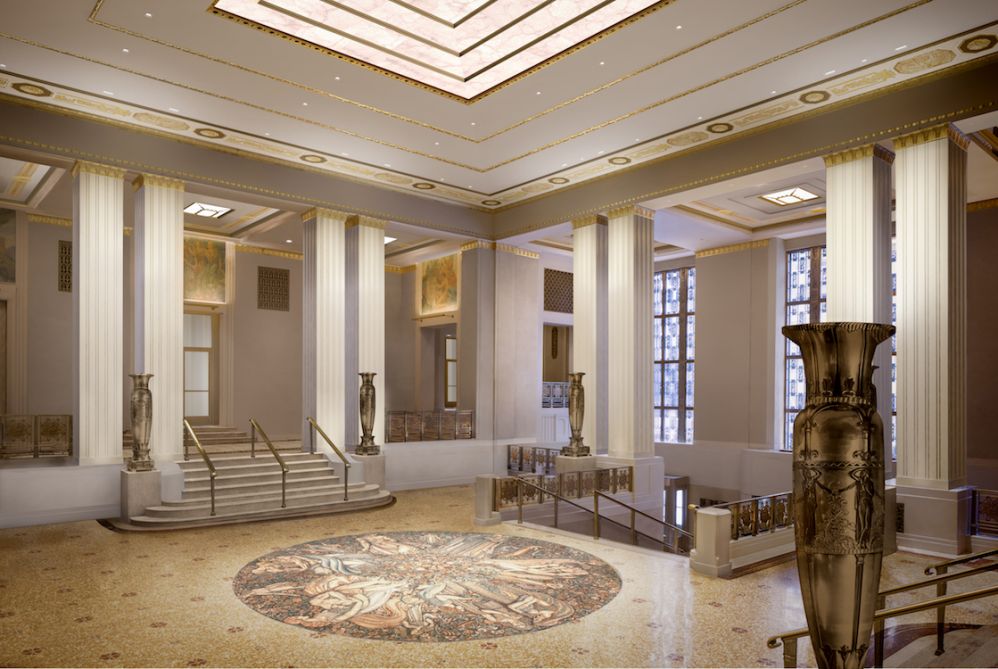
Park Avenue foyer
A rendering of what the foyer located near Park Avenue would look like. Several areas of the Waldorf Astoria’s interior, including this foyer, were designated official city landmarks in 2017.(Credit: Skidmore, Owings & Merrill LLP / Rendering by Methanoia Inc.)
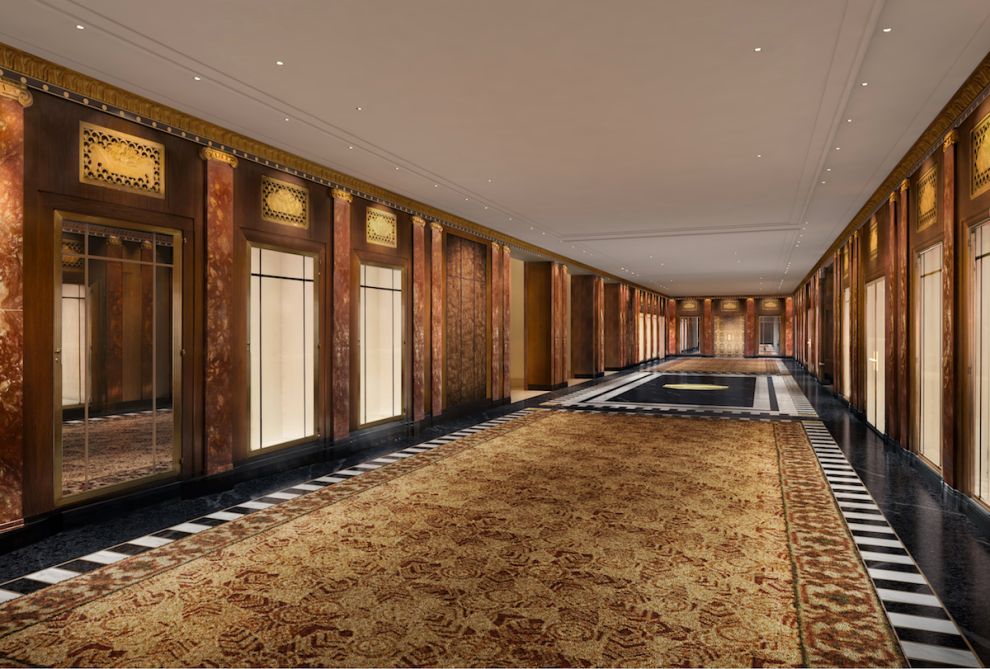
Peacock Alley
A rendering of the entry to Peacock Alley, a restaurant inside the Waldorf Astoria.(Credit: Skidmore, Owings & Merrill LLP / Rendering by Methanoia Inc.)
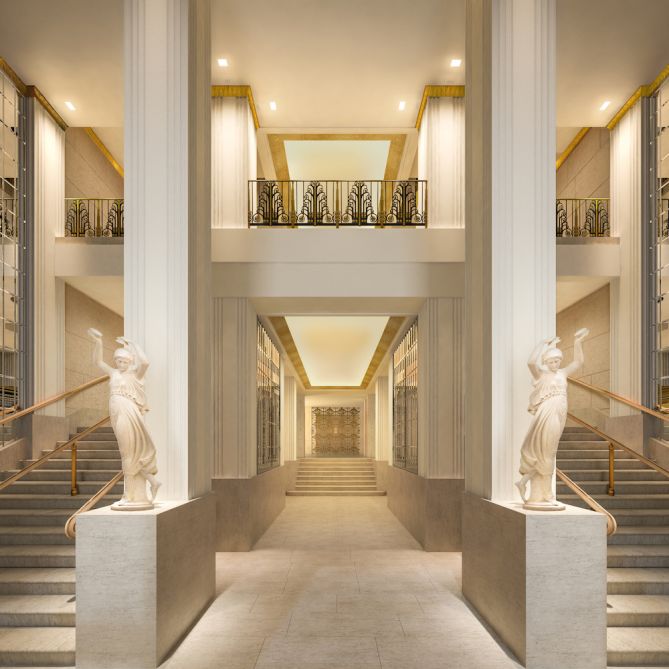
Lexington Avenue entryway
A rendering of the restoration planned for the entryway located on Lexington Avenue.(Credit: Skidmore, Owings & Merrill LLP / Rendering by Methanoia Inc.)

